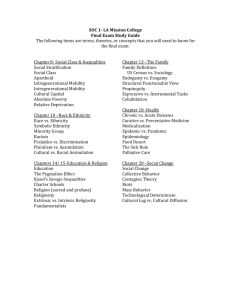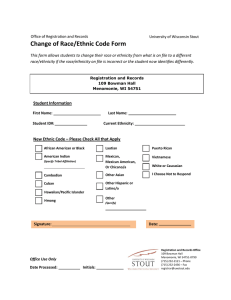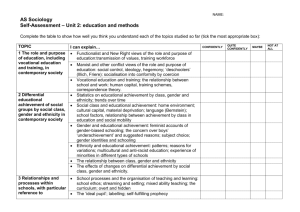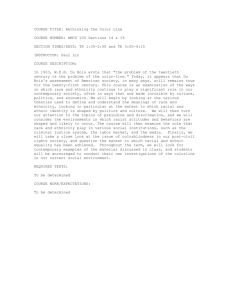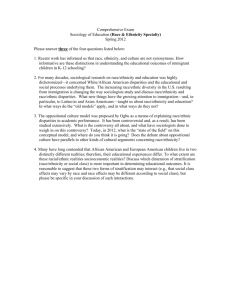Racial and Ethnic Relations/SOCY 240 Course Syllabus Spring 2014 Prof. Tricarico
advertisement
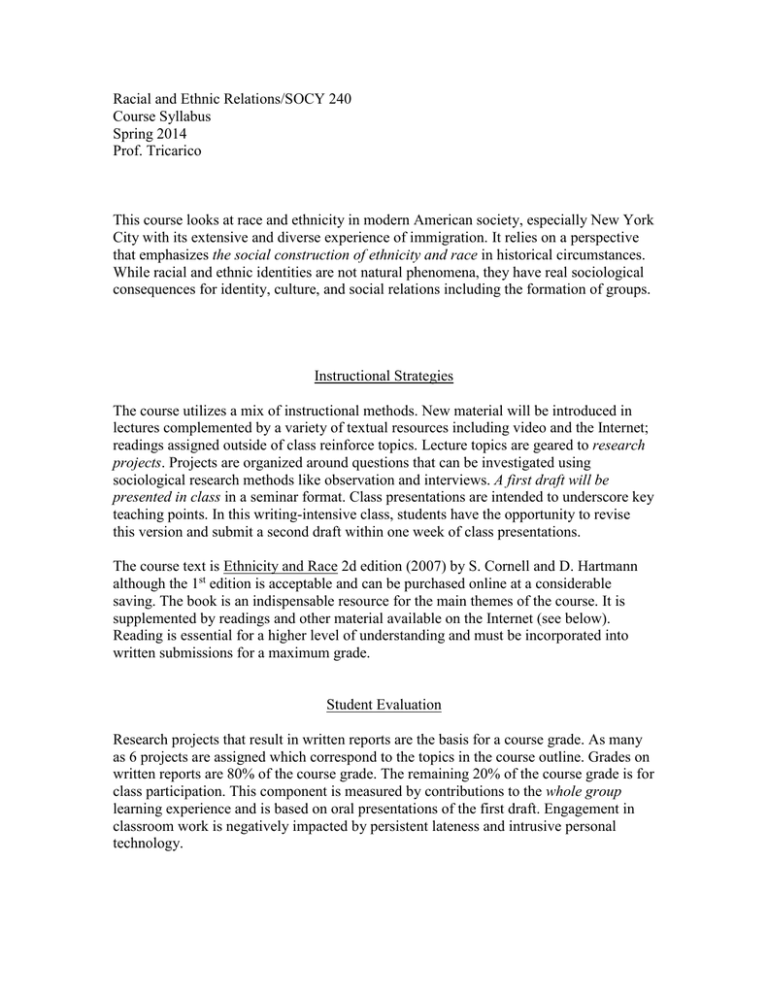
Racial and Ethnic Relations/SOCY 240 Course Syllabus Spring 2014 Prof. Tricarico This course looks at race and ethnicity in modern American society, especially New York City with its extensive and diverse experience of immigration. It relies on a perspective that emphasizes the social construction of ethnicity and race in historical circumstances. While racial and ethnic identities are not natural phenomena, they have real sociological consequences for identity, culture, and social relations including the formation of groups. Instructional Strategies The course utilizes a mix of instructional methods. New material will be introduced in lectures complemented by a variety of textual resources including video and the Internet; readings assigned outside of class reinforce topics. Lecture topics are geared to research projects. Projects are organized around questions that can be investigated using sociological research methods like observation and interviews. A first draft will be presented in class in a seminar format. Class presentations are intended to underscore key teaching points. In this writing-intensive class, students have the opportunity to revise this version and submit a second draft within one week of class presentations. The course text is Ethnicity and Race 2d edition (2007) by S. Cornell and D. Hartmann although the 1st edition is acceptable and can be purchased online at a considerable saving. The book is an indispensable resource for the main themes of the course. It is supplemented by readings and other material available on the Internet (see below). Reading is essential for a higher level of understanding and must be incorporated into written submissions for a maximum grade. Student Evaluation Research projects that result in written reports are the basis for a course grade. As many as 6 projects are assigned which correspond to the topics in the course outline. Grades on written reports are 80% of the course grade. The remaining 20% of the course grade is for class participation. This component is measured by contributions to the whole group learning experience and is based on oral presentations of the first draft. Engagement in classroom work is negatively impacted by persistent lateness and intrusive personal technology. Attendance Following college policy, students are allowed 6 hours of unaccounted absence. Persistent lateness must be remedied (see above). Contact Office Hours: TBA in M121 Dtricarico@qcc.cuny.edu Topic Outline Common sense understandings of ethnicity and race: a baseline for scholarly discussion a) How does ethnicity and race matter in American society? b) Why does ethnicity and race matter? Read: Chapter 1 (Cornell and Hartmann) Sociological definitions of ethnicity and race a) Ethnicity as a belief in shared ancestry b) Race as biology and a social category c) Similarities of ethnicity and race Read: Chapter 2 Theoretical perspectives a) A social constructionist approach to ethnicity and race b) Ethnicity and race as asserted and assigned identities c) Ethnicity and race as categories within a society Read: Chapter 4 The social significance of ethnicity and race a) Macro-sociological patterns (e.g. police strategies and incarceration rates, affirmative action in higher education, residential segregation and job discrimination) b) Micro-sociological patterns (e.g., interaction in public spaces, mate selection, residential location). Read: Chapters 5, 6, 7 A typology of intergroup relations a) Accommodation b) Alignment and mixing c) Competition d) Conflict Read: Chapters 5, 6, 7 Assimilation a) Definition, historical context, and major theoretical approaches b) Dimensions of assimilation: process and sequence c) Partial and Segmented assimilation: Race and Class d) New ethnicities (e.g., Latinos) e) Post-racial America? Read: Chapters 3 and 8 Supplementary Readings: Gordon, Milton 1964. Assimilation in American Life. New York: Oxford. Portes, A. and Min Zhou. 1993. “The New Second Generation: Segmented Assimilation and Its Variants”. Annals of the American Academy of Political and Social Science 530 (November):74-97. Tricarico, Donald 1984a. The Italians of Greenwich Village. Staten Island: Center for Migration Studies ______ 1984b. “The ‘New’ Italian American Ethnicity” in The Journal of Ethnic Studies (Spring): ______ 1991. “Guido: Fashioning an Italian American Youth Subculture” in The Journal of Ethnic Studies (Spring):41-66. ______ 2001. “Read All About It! Representations of Italian Americans in the Print Media in Response to the Bensonhurst Racial Killing” in Notable Selections in Race and Ethnicity, edited by A.A. Aguirre and D.V. Baker: 291-319. _____ 2008. “Dressing Italian Americans for the Spectacle: What Difference Does Guido Perform?”, The Men’s Fashion Reader, edited by A. Reilly and S. Cosbey, New York: Fairchild:265-278. 2010. “Narrating Guido: Contested Meanings of an Italian American Youth Subculture” in W.J. Connell and F. Gardarphe, eds., Anti-Italianism: Essays on Prejudice (New York: Palgrave Macmillan), 163-199. Waters, Mary 1990. Ethnic Options. Berkeley: U. of California Press Video Used in Class “Farmingville” (DVD) “Carrier” (PBS): “Divisions” (Episode 4, Chapter 3) Race: Not Biological (Youtube) The Amish of Ohio (PBS/Youtube) “Italian Americans: Our Contributions” (Youtube) “African American Lives”, I and II (PBS) Interview with Elijah Anderson on “Cosmopolitan Canopy” (FOX Philly web site, 12 May 2011) 8) “Magic and Bird” (ESPN/Youtube) 9) “My American Girls” (DVD) 1) 2) 3) 4) 5) 6) 7) Project 1: Definitions Discuss the concepts of ethnicity and race that have social scientific rigor. Rely on Cornell and Hartmann, class notes, and support materials like the video “Race: Not Biological”. Directly address the following points: • What definitions of ethnicity have merit for the authors? What is their view? • How is race a construct that is both “biological” and “social”? • What are the commonalities and differences between ethnicity and race? Project 2: Finding Ethnicity in Your Everyday Life For this project, you will pair up with another student in class to conduct an interview. Interview questions are provided below. Your paper is based on responses to questions put to you during the interview. The interview is intended to find how ethnicity can matter in the social world. Take into account identities referenced to nationality, religion, and race. Also note “new ethnicities” like Latino, Caribbean, and Asian. Focus on: • • • • The family and especially parents, grandparents, and the wider kinship group Friends and the peer group Dating and marriage partners Community including the neighborhood 1. To what extent is ethnic identity explicitly or consciously invoked to define these relationships? To what extent is ethnicity implicit and taken-for-granted in these worlds? How does ethnicity matter in these relationships or groups? Consider the role of ethnicity a) as a credential of membership or social boundary; b) as a source of 2. 3. 4. 5. cultural content (i.e., a script referenced to a heritage), and; c) claims of invidious status (i.e., that one group is “better” than or superior to another in things that matter). To what extent does ethnicity matter less or become unimportant when measured against your parents’ and grandparents’ generation? In conclusion, assess how important is ethnicity in the overall scheme that is your life by comparing it to other identities that you hold.


